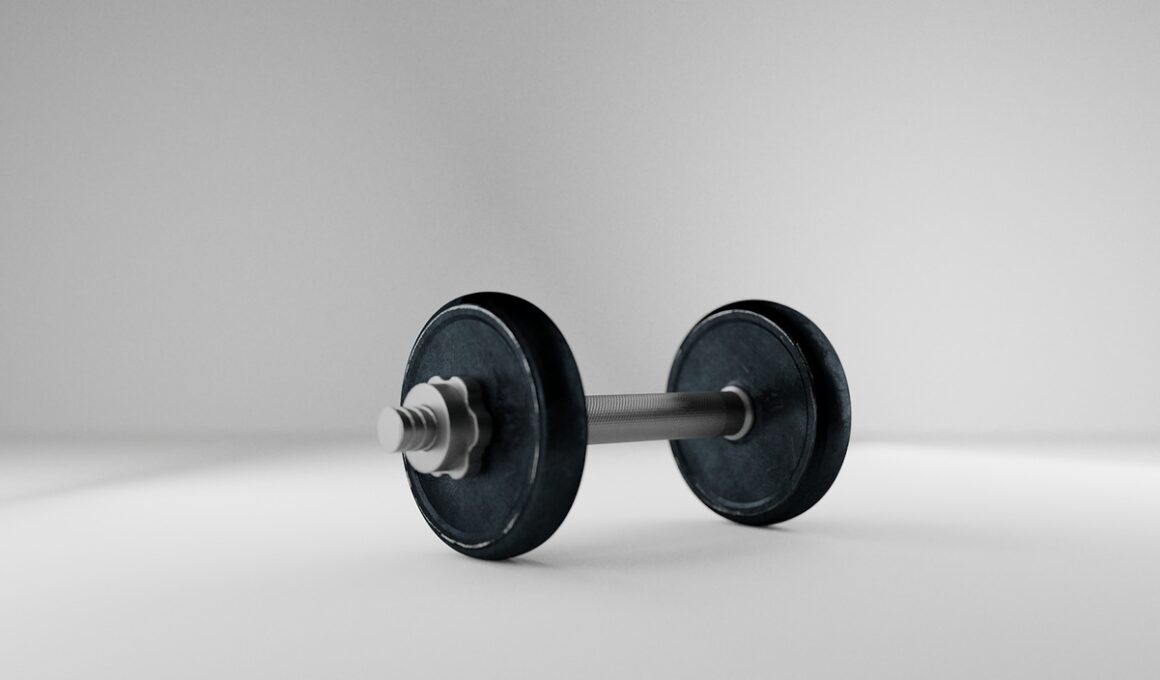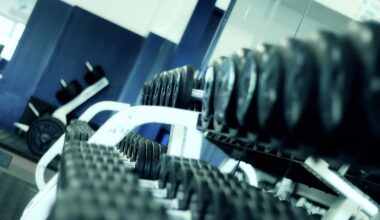Training Equipment: Best Tools for Bodybuilding and Strength Training
When it comes to bodybuilding and strength training, having the right equipment is essential for achieving optimal results. Over time, various tools have been developed to cater to different aspects of training, whether for building muscles or increasing strength. Understanding which tools to use can greatly enhance your workout efficiency and effectiveness. Common choices include free weights, resistance bands, and machines designed for specific muscle groups. This diversity allows you to tailor your workouts based on personal goals and preferences, maximizing the benefits of each session. Personal trainers often emphasize the importance of selecting the right tools to avoid injuries while ensuring that you achieve your desired body transformation in a healthy manner. Additionally, the right equipment can aid in tracking progress and preventing plateaus in strength gains. As different training methodologies evolve, having access to modern equipment allows for versatility and variety in workouts. In the following sections, we will delve deeper into the best tools necessary for both bodybuilding and strength training to help anyone whether they are beginners or seasoned athletes.
Key Equipment for Bodybuilding
Bodybuilders require specific equipment to sculpt their physiques effectively. Free weights, such as dumbbells and barbells, are essential as they engage multiple muscle groups, providing a comprehensive workout. These weights not only build muscle mass but also encourage stability and coordination. Additionally, machines like the leg press or chest press provide isolation for specific muscle groups, allowing bodybuilders to target areas that need improvement. Moreover, equipment such as resistance bands offers versatile workouts and can be used virtually anywhere. These bands are especially useful for warming up or adding variety to routines, making exercises more dynamic and effective. Adjustable benches are also crucial in bodybuilding, as they provide support for a plethora of exercises, from bench presses to seated rows. Cable machines are another fantastic option, enabling a full range of motion and continuous tension throughout the lifting process. Finally, squat racks are paramount for safely executing compound movements like squats, a fundamental exercise for any bodybuilder aiming for overall development. Incorporating these tools into regimes ensures a well-rounded, aesthetically pleasing physique.
When talking about strength training, important equipment includes weights, benches, and resistance tools for bodyweight workouts. Barbells are well-known for their versatility, allowing for complex lifts that enhance strength in various areas. They can be used for traditional lifts like deadlifts, squats, and bench presses. This equipment can help attain strength effectively if incorporated correctly into a structured program. Furthermore, kettlebells are gaining popularity due to their ability to perform dynamic movements that promote both strength and cardiovascular fitness. Their unique design allows for swings and cleans that target multiple muscle groups simultaneously. Additionally, adjustable dumbbells can save space and provide a wide range of weight options, making them perfect for home gyms. Bands, too, offer a unique type of resistance training, helping maintain tension on muscles throughout various lifts, enhancing strength and stability. Moreover, foam rollers can aid recovery and flexibility, aspects often overlooked in strength training. All of these tools combined create a comprehensive strength training regimen that focuses on muscle growth, injury prevention, and overall performance enhancement.
Importance of Proper Technique
No matter the equipment chosen, proper technique is crucial to avoid injuries and ensure productive workouts. The effectiveness of bodybuilding and strength training largely depends on the correct execution of exercises. Performing lifts with improper form can lead to strains, discomfort, and potentially serious injuries. Thus, investing time in learning the proper techniques for each exercise is necessary for any fitness enthusiast. Engaging a personal trainer or attending classes can help individuals understand how to position their bodies correctly during lifts. Moreover, video resources can serve an excellent supplement for self-learning, with visuals demonstrating how to perform exercises safely. Starting with lighter weights while mastering the form is essential, gradually increasing the load as confidence and strength grow. Regular self-assessments using mirrors or workout partners can help ensure that movements remain aligned with proper technique. This diligence can also enhance the mind-muscle connection, making workouts more effective. Ultimately, the focus on safe and effective exercise form should never be overshadowed by the amount of weight being lifted, as technique leads to long-term success in bodybuilding and strength training.
To enhance workouts, investing in additional gear recommended for bodybuilding and strength training can significantly improve overall performance. Some popular items include lifting belts, which offer support during heavy lifts, stabilizing the core and reducing the risk of injury. In addition, wrist and ankle weights can increase resistance in specific exercises without requiring bulky equipment. Also, resistance grips can be utilized for enhancing grip strength and control over lifts. Proper footwear is often overlooked; specialized gym shoes can provide the necessary support, stability, and traction when attempting heavy lifts. Another vital accessory includes shaker bottles for protein shakes and hydration, contributing to post-workout recovery. Otherwise, foam mats or structured flooring can provide comfort during floor exercises, reducing the impact on joints. Additionally, adjustable benches enhance versatility, allowing for declined, flat, or inclined positions needed for various exercises. All of these accessories add significant value to workouts, allowing individuals to target muscle groups more effectively while enhancing comfort and support while lifting heavy weights. Investing in quality gear ensures that workouts are productive and safe, ultimately aiding in achieving fitness goals.
Setting Up a Home Gym
With the right plans and motivation, establishing a home gym for bodybuilding and strength training is possible and beneficial. A home gym provides flexibility in scheduling workouts without the hassles of commuting to a commercial gym. Start by assessing available space; it may not need to be large, just a dedicated area for workouts is essential. Basic equipment can easily accommodate home gyms; for instance, adjustable dumbbells, resistance bands, a stability ball, and a bench can provide a well-rounded set up. As you progress and get more serious, consider adding more advanced equipment like a squat rack or a cable machine. Furthermore, creating a motivational atmosphere is vital; paint the walls in energizing colors, hang motivational quotes, and ensure the room is well-lit and ventilated. Organizing equipment helps to keep the space clutter-free, promoting better focus during workouts. Additionally, tuning into workout music can boost energy levels and enhance performance. A home gym not only saves time and money in the long run, it also allows individuals to build a personalized training environment catering directly to their preferences.
Finally, safety and maintenance of training equipment are crucial aspects that should not be overlooked. Proper care extends the lifespan of the tools and ensures they continue delivering optimal performance. Regularly inspect strength training equipment for any signs of wear or damage, like frayed cables or rust on weights. Maintaining a clean space is essential, as sweat and dust can accumulate on equipment, contributing to wear and can pose risks. Using a damp cloth to wipe down weights and machines after use can enhance hygiene and prolong the life of the equipment. Furthermore, ensure exercise surfaces are not slippery, reducing the chance of accidents. Securely store items when not in use, preventing tripping hazards in the area. Finally, make sure to follow the manufacturer’s guidelines for maintenance, as each piece of equipment may have specific requirements. Implementing these practices curtails potential injuries and ensures that the equipment remains functional for a long time. In conclusion, investing time into safety and maintenance optimizes gym experiences, leading to continued growth and achievements in bodybuilding and strength training pursuits.
To summarize the discussion about training equipment for bodybuilding and strength training, it’s essential to recognize the diversity of tools available that can enhance workout experiences. Each piece of equipment, from free weights to advanced machines, plays a significant role in achieving specific fitness goals. Understanding how to combine various tools while focusing on form and technique remains paramount for success. Additionally, creating a dedicated workout space in the home allows significant flexibility in schedule and access to necessary gear. Beyond just equipment, considering aspects like safety and maintenance ensures longevity and efficiency. Investing in the right accessories tailored to personal needs can also elevate the experience, enhancing comfort and effectiveness. Remember to continually assess your goals and modify your routine as progress is made. Whether your focus is on bodybuilding for visual aesthetics or strength training for athletic performance, the equipment used will undoubtedly make a difference. By prioritizing the purchase of quality equipment, incorporating proper techniques and focusing on equipment maintenance, individuals can pave the way for enduring success in their fitness endeavors.


